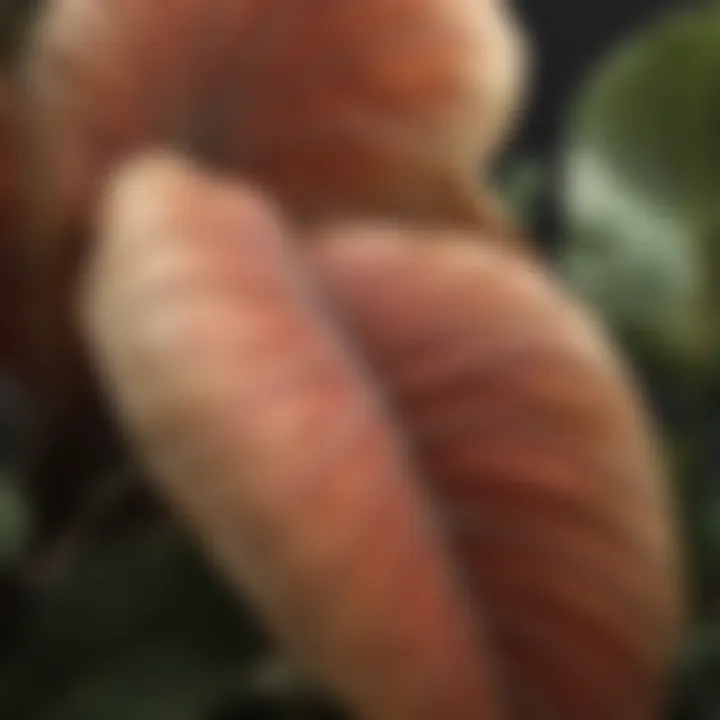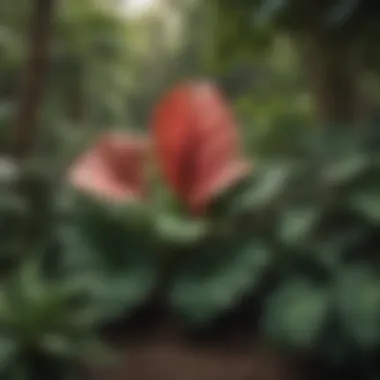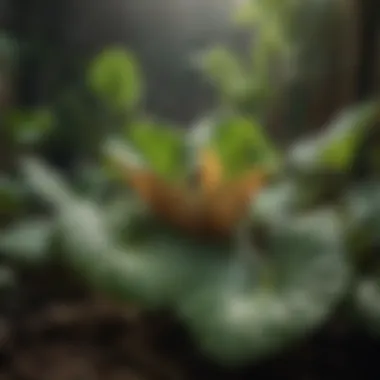Ultimate Guide to Colossal Elephant Ear Bulbs


Intro
Colossal elephant ear bulbs are more than just plants; they are a statement. These large-leaved wonders belong to the genus Alocasia and Colocasia, both flourishing in tropical regions. Their massive leaves provide striking visuals, making them popular for those who wish to make a grand statement in their gardens or homes. Understanding the intricacies of these plants is vital for anyone looking to enhance their space.
The significance of these bulbs transcends mere aesthetics. They are symbols of natural beauty and sustainable gardening. With proper care, they can thrive for years, offering lush greenery and vibrancy to any environment. As we examine their origins, cultivation, and design applications, it becomes clear that they hold immense potential, whether indoors or outdoors.
This guide aims to equip homeowners, gardening enthusiasts, and design aficionados with the essential knowledge needed to incorporate colossal elephant ear bulbs effectively. From understanding their unique requirements to exploring their role in modern design, we will cover it all.
Design Inspiration
Current Trends in Interior Design
In the world of interior design, incorporating natural elements has never been more in vogue. Colossal elephant ear bulbs fit seamlessly into this trend, offering a dramatic focal point. As spaces evolve, there is a shift towards biophilic designs that emphasize a connection with nature. These plants serve as a bridge between the interior and the outside world.
They can be utilized in various styles, from minimalistic to eclectic. When placed in large pots, they can anchor a room, providing height and depth that smaller plants rarely achieve. Many designers favor them for their versatility; they can complement a range of color schemes and aesthetics.
Color Schemes and Palette Ideas
When it comes to color, elephant ear plants bring a palette of greens that can harmonize beautifully with interior settings. They pair well with a variety of hues, enhancing both bright and subdued color schemes. For instance:
- Neutral Tones: These plants can brighten greys and beige spaces, adding life without overwhelming the area.
- Bold Colors: If your interior features vibrant colors, the rich green leaves can act as a calming balance.
- Earthy Shades: They tie in well with browns and terracottas, resonating with a natural theme.
Using these plants throughout a space can create a cohesive design narrative, fostering an environment that feels as refreshing as it is stylish.
"Integrating colossal elephant ear bulbs into your interior design can transform any room, making it feel alive and inviting."
Gardening Techniques
Plant Selection and Care
Selecting the right type of colossal elephant ear bulb is pivotal. Popular varieties include the Alocasia Amazonica and Colocasia esculenta. Each type brings unique leaf shapes and colors, influencing the overall aesthetic you wish to create. Proper care involves understanding their specific needs:
- Soil: Well-draining potting mix is essential. Adding perlite can enhance drainage.
- Watering: These plants prefer moist soil but dislike being waterlogged. Consistency is critical; check the topsoil before watering.
- Light: They thrive in bright, indirect light, so placing them near windows with filtered sunlight is ideal.
Neglecting these essentials can hinder their growth and vibrancy.
Indoor vs. Outdoor Gardening
Deciding to grow colossal elephant ear bulbs indoors or outdoors depends on climate and available space. Indoors, they become striking conversation pieces, while outdoors, they can create lush landscapes.
- Indoor Gardening: Ensure sufficient light and humidity to mimic their natural environment. Avoid placing them near drafts or heating vents.
- Outdoor Gardening: Choose a location with partial shade, especially in hotter climates. Mulching can help retain soil moisture and suppress weeds.
Understanding the differences between indoor and outdoor cultivation ensures the long-term health of these remarkable plants.
Preface to Colossal Elephant Ear Bulbs
Colossal elephant ear bulbs are more than just plants; they are a powerful statement in any garden or interior design. Their notable size and unique foliage can transform ordinary spaces into vibrant displays of nature. Understanding their features and needs is vital for anyone looking to incorporate them into their environment. This section focuses on the importance of these bulbs, highlighting their role in aesthetics and the benefits they provide.
Defining Colossal Elephant Ears
Colossal elephant ears, scientifically known as Alocasia or Colocasia, are tropical plants characterized by giant, heart-shaped leaves that can reach impressive sizes. The name "elephant ear" derives from the resemblance these large leaves have to the ears of an elephant. Typically, these plants thrive in warm, humid environments, making them popular choices for gardeners in subtropical and tropical climates.
The foliage serves not just for aesthetics but also for environmental benefits. They create shade and keep soil moisture levels balanced, which can be crucial for maintaining the health of companion plants. Moreover, their striking appearance draws attention in gardens or homes, acting as focal points in landscaping or interior decor.
Botanical Classification
Colossal elephant ear bulbs belong to two main genera: Alocasia and Colocasia, which are part of the Araceae family. The classification depends on the specific species within these genera. The Colocasia esculenta, often referred to as taro, is a well-known cultivar.
These plants are perennial in their native habitats but often treated as annuals in cooler climates. Colloquially, they are referred to as elephant ear plants due to their distinctive leaf shape.
In terms of botanical characteristics, colossal elephant ears exhibit a variety of features:
- Leaf Structure: Leaves can be glossy green or ruffled, contributing to an elegant look.
- Height: Depending on the variety, they can grow up to 8 feet tall.
- Roots: The bulbs serve as a storage organ for nutrients, allowing the plant to survive periods of drought.
Understanding the botanical classification of these plants contributes to better care and maintenance practices, ensuring that both novice and experienced gardeners can successfully cultivate them.


Origins and History
Understanding the origins and history of colossal elephant ear bulbs provides important context for their cultivation and uses. These plants are not just visually striking; they carry cultural and botanical significance rooted in their native regions. Exploring their background allows gardeners and designers to appreciate how to integrate them meaningfully into their projects. Knowledge about their historical cultivation has significant implications for sustainable gardening practices and modern design applications.
Native Regions
Colossal elephant ears, primarily the species Alocasia and Colocasia, are native to tropical and subtropical regions. The largest populations are found in Southeast Asia, particularly in countries like Malaysia and Philippines. These areas provide the warm and humid conditions optimal for their growth.
Each native region contributes distinct characteristics to the plant. For example, some varieties thrive in wet, marshy environments, while others prefer well-drained soils. This diversity is crucial for gardeners. By understanding the specific growing conditions of each native species, one can better replicate their natural habitats.
Wild habitats exhibit unique aesthetics. This shows how colossal elephant ears adapt to their environment. The broad leaves and large sizes are evolutionary benefits. They maximize sunlight capture while minimizing water loss. This aspect is critical for outdoor gardening as well as indoor plant care. It ensures that anyone looking to cultivate these bulbs can provide a suitable environment matching their needs.
Cultural Significance
Colossal elephant ears also hold cultural significance in various regions. They are often linked to prosperity and protection. In some cultures, these plants are used in ceremonies, believed to bring good fortune to households. These bulbs may also have medicinal uses. In certain communities, the leaves are used in traditional remedies, representing a blending of aesthetics with utility.
In addition to their traditional roles, these plants have made their way into modern gardens and landscaping. The appeal of colossal elephant ears goes beyond practicality; they symbolize exotic beauty. Their striking appearance invites homeowners and designers alike to experiment with their integration into diverse styles. The visual impact of these plants can transform any garden space or interior environment.
"The colossal elephant ear bulb is more than a plant; it embodies stories of cultures and climates."
The importance of understanding the origins and cultural significance of these plants cannot be overstated. By appreciating their history, growers can create more informed decisions regarding care and design application. This knowledge also fosters a deeper connection between the gardener and the plants, enhancing the overall experience of cultivation.
Characteristics of Colossal Elephant Ear Bulbs
Understanding the characteristics of colossal elephant ear bulbs is essential for both gardening enthusiasts and interior design aficionados. These plants, notable for their impressive foliage and grandeur, serve as focal points in any setting. Their size, color, and unique leaf structures contribute to their appeal.
Size and Shape
The size and shape of colossal elephant ear bulbs are defining features. The leaves can expand to impressive dimensions, often reaching widths of three to five feet or more. This characteristic adds a tropical feel to gardens and indoor spaces alike, providing a lush aesthetic that few other plants can match.
When choosing these bulbs, it is crucial to consider the allowed space for growth. A well-planned arrangement takes into account not only width but also the height these plants can achieve. Their robust, upright stems create an architectural interest, making them ideal for both standalone and grouped displays. This element of physical presence is a significant benefit for those looking to create dramatic landscapes or inviting interiors.
Color Variations
Colossal elephant ear bulbs are not merely green; they present a spectrum of color variations. Common varieties include shades of green, purple, and even variegated types.
- Green Varieties: The most prevalent, offering a classic tropical look.
- Purple Varieties: These add intrigue and contrast, especially when paired with lighter foliage.
- Variegated Varieties: Combining colors can enhance visual complexity in designs.
Adding these colors to gardens or interiors can produce a vibrant atmosphere, refreshing spaces with unique color combinations. The selection of specific colors can be tailored to enhance design themes, ensuring that these plants are not only functional but also decorative.
Leaf Structures
The leaf structures of colossal elephant ear bulbs deserve close attention for several reasons. They typically exhibit a heart-shaped form and are known for their lobed outlines, which create a striking silhouette. The substantial leaves also function as natural filters, softening harsh light in a garden or room.
These leaves have a waxy coating that helps retain moisture, an important trait during hot and dry periods. Additionally, their veins run prominently, providing a visually appealing texture that contrasts well with smooth surfaces in landscaping or interior design.
To best showcase their leaf structures, consider planting in mixed beds or pairing with plants of differing heights and textures. This arrangement contributes not only to visual interest but also to the health of the garden ecosystem.
"The size, color, and unique leaf structures of colossal elephant ear bulbs are essential to their appeal and functionality in design."
In summary, the characteristics of colossal elephant ear bulbs play a crucial role in their selection for cultivation. Understanding these elements allows homeowners and designers to use them effectively in various settings, ensuring that they contribute positively to the desired aesthetic.
Cultivation Techniques
Cultivation techniques for colossal elephant ear bulbs are crucial for ensuring the health and vibrancy of these striking plants. Proper practices lead to abundant growth and beautiful foliage, providing impactful visuals for any garden or interior space. Each step in the cultivation process plays a unique role; understanding these elements enables effective management of this plant species.
Selecting the Right Bulbs
When aiming for successful cultivation, selecting the right bulbs is fundamental. Choose bulbs that are firm, free from blemishes or soft spots. Look for larger sizes as they often yield stronger plants that grow more rapidly. The ideal bulbs should have at least 10-15 cm in diameter. Ensure the source of your bulbs is reputable. Local nurseries, or established online retailers, usually provide high-quality options. Consider the specific variety of colossal elephant ears, such as Alocasia or Colocasia, as each may have different traits and growing needs. Also, it is wise to check seasonal availability since this will impact your planting timeline.
Soil Requirements
The soil composition plays a pivotal role in the healthy growth of colossal elephant ears. They thrive in well-draining, nutrient-rich soil. A mixture of potting soil, compost, and peat moss enhances aeration while retaining moisture. Typically, a pH level between 5.5 to 7.0 is favorable. It is beneficial to amend heavy soils with sand or perlite to improve drainage. For container growth, ensure that pots have adequate drainage holes to prevent waterlogging. Proper soil conditions promote robust root development, which is essential for overall plant health.
Watering and Sunlight Needs


Colossal elephant ear bulbs require consistent watering and attention to sunlight placement. Ensure that the soil remains moist, not soggy; too much water can lead to rot. During the growing season, apply a deep watering technique to encourage root growth. An average of 1-2 inches of water per week is generally sufficient, but adjust based on climatic conditions. Also, ample sunlight is vital. These plants prefer bright, indirect sunlight. Too much direct sun can scorch the foliage. A mix of full sun in the mornings and partial shade in the afternoons tends to work well for robust leaf development.
Propagation Methods
Propagation of colossal elephant ear bulbs can be achieved through various methods. The most prevalent way is through bulb division. This technique involves carefully separating larger bulbs into smaller pieces, ensuring that each section has some roots. It is best to perform this division during the dormancy phase, typically in late winter or early spring. Another method is offset propagation, where smaller bulbs that form around the base of mature plants can be detached and replanted. For those interested in seed propagation, it is less common but possible; seeds should be collected after the flowering phase and planted immediately, as they have low viability if stored for long periods.
"Healthy cultivation practices not only yield better plants but also enhance the overall aesthetic of your space."
In summary, understanding the techniques of cultivation—from selecting the right bulbs to mastering soil and water needs—will empower anyone looking to integrate colossal elephant ears into their environments. These plants require attention and care, but the rewards are visually stunning and well worth the effort.
Care and Maintenance
Care and maintenance are essential components for achieving healthy and vibrant colossal elephant ear bulbs. These massive plants require thoughtful attention to thrive. Proper care helps to prevent issues and ensures longevity in gardens or interiors. Below, we discuss key areas you should consider for optimal maintenance and care.
Fertilization Practices
Fertilization plays a crucial role in the growth of colossal elephant ear bulbs. They benefit from a balanced nutrient mix. Using a slow-release fertilizer can provide essential nutrients over time. Look for fertilizers that contain nitrogen, phosphorus, and potassium in equal ratios. A specific NPK ratio of 10-10-10 can work well.
Applying fertilizer during the growing season is ideal. Start in early spring before growth begins and continue every 4 to 6 weeks. Ensure that the soil remains moist when applying fertilizer to avoid burning the roots. Over-fertilizing can lead to excessive foliage growth at the expense of the bulbs themselves.
Tip: Always read the instructions on fertilizer packaging. Different products may have varying application requirements.
Pest Management
Pest management is vital to protect colossal elephant ears from potential damage. Common pests include aphids, spider mites, and mealybugs. Regularly inspect the leaves for signs of infestation, such as yellowing or sticky residue.
Integrating natural pest control methods can minimize chemical usage. For instance, introducing predatory insects like ladybugs helps to control aphids. Alternatively, you can use insecticidal soap as a more direct approach to manage populations effectively. Always apply treatments in the early morning or late evening to avoid harming beneficial insects.
Here are some preventative measures:
- Ensure good air circulation around the plants.
- Remove any dead or decaying plant matter.
- Regularly clean garden tools to avoid spreading pests.
Seasonal Care Tips
Seasonal changes require distinct care approaches for colossal elephant ears. In summer, they thrive with ample sunlight and moisture. However, in winter, protection against frost becomes paramount. When temperatures drop, either lift the bulbs or provide mulch for insulation if planted outdoors.
During periods of heavy rainfall, ensure drainage is adequate to prevent rot. In dry spells, maintaining a consistent watering schedule is key. Check the soil regularly to determine moisture levels—keep it consistently moist but not soggy.
Here is a quick overview of seasonal care:
- Spring: Start fertilization and bud watch.
- Summer: Monitor for pests and maintain soil moisture.
- Fall: Prepare for bulb lifting or mulching.
- Winter: Protect bulbs from freezing temperatures.
In summary, diligent care and maintenance practices enrich the experience of growing colossal elephant ear bulbs. Pay attention to fertilization, pest management, and seasonal adjustments to ensure a flourishing growth cycle.
Design Applications
The integration of colossal elephant ear bulbs into various design applications is a powerful approach for enhancing both indoor and outdoor spaces. Their striking foliage and grand presence can elevate any environment, making them a focal point in gardens or interior design schemes. Understanding the specific elements and benefits of incorporating these plants can lead to innovative uses that not only beautify but also functionalize a space.
Garden Aesthetics
In gardens, colossal elephant ear bulbs serve as architectural plants that add structure and dynamic shapes. Their enormous leaves can dramatically contrast with smaller flowering plants, providing a lush backdrop. Key considerations when using these bulbs include:
- Placement: Positioning these bulbs in the right spot maximizes their visual impact. They thrive in areas with ample sunlight and moist soil.
- Color Coordination: Pairing them with other plants that complement their bold green hues can create a cohesive look, enhancing overall garden aesthetics.
Using colossal elephant ears in borders or as standalone statements helps frame garden pathways. When planted in groups, they create a tropical feel, inviting viewers to explore. Careful selection of companion plants can influence the overall garden theme, from serene retreats to lively, colorful displays.
Indoor Usage
For indoor spaces, colossal elephant ear bulbs present an opportunity for lush, natural decor. The large leaves provide significant visual interest, appealing to those seeking to introduce a touch of the outdoors into their homes. When placing these plants indoors, one should consider:
- Light Requirements: Ensure adequate sunlight to prevent drooping or yellowing leaves.
- Pot Selection: Choose pots that match the decor style while allowing for drainage to maintain bulb health.
Setting these plants in living rooms, sunrooms, or even offices can enhance the ambiance. They are effective at softening hard edges in modern design and complementing minimalist aesthetics. Additionally, these plants can purify the air, adding health benefits to their visual impact.
Combining with Other Plants


Combining colossal elephant ear bulbs with other plants can create stunning, multi-dimensional displays. The large leaves can provide a contrast to smaller or finer-leaved plants, thereby enhancing textures and colors in a garden or indoor setting. Considerations for plant combination include:
- Height Variation: Use smaller plants or ground covers around the base of the bulbs to create layers in your space. This will help draw the eye upward and make the colossal bulbs appear even larger.
- Foliage Texture: Mixing in plants with various leaf shapes and colors can create a lively botanical tapestry. For example, combining with ferns or hostas can enhance the tropical vibe.
Opting for complementary flowering plants that bloom at different times will ensure continuous color throughout the seasons. When cultivated alongside herbs or edible plants, colossal elephant ears can also serve practical purposes, enriching both the aesthetic and functional aspects of a garden.
Improper pairing can lead to overcrowding, which may hamper air circulation. Make careful selections to ensure each plant has room to thrive and be appreciated.
Challenges in Cultivation
Cultivating colossal elephant ear bulbs can be a rewarding experience. However, it does come with its own set of challenges that growers must navigate. Understanding these challenges is crucial for ensuring the proper growth and health of the plants. By being aware of common diseases and environmental factors, enthusiasts can implement strategies to mitigate issues.
Common Diseases
One of the most significant hurdles in nurturing colossal elephant ear bulbs is managing diseases. These plants, while robust, are susceptible to various ailments.
- Leaf Spot: Caused by fungi, this disease manifests as brown or yellow spots on the leaves. It thrives in wet conditions, making watering practices vital. Avoid over-watering and ensure good air circulation.
- Root Rot: This is a serious threat, typically from poor drainage. Roots become mushy and decay, which can lead to plant death. Prevent this by planting bulbs in well-draining soil and avoiding excessive moisture.
- Aphid Infestation: These tiny pests can suck plant sap, leading to weakened growth. Regular inspection or the use of mild insecticides can help control their spread.
- Fungal Infections: Like downy mildew, these issues stem from high humidity and poor airflow. Keep an eye out for powdery spots on the leaves and take action swiftly by improving ventilation.
Maintaining general plant hygiene, such as removing dead or diseased foliage, can minimize these disease risks.
Environmental Factors
Environmental factors play a crucial role in the cultivation of colossal elephant ear bulbs. They favor humid and warm climates, which can be challenging in varying weather conditions.
- Humidity Levels: These plants thrive in humid environments. A lack of humidity can cause leaf curling and overall poor health. Consider using misting methods or placing them on trays with water and pebbles to increase moisture levels around the plants.
- Temperature: Colossal elephant ears prefer warm temperatures, ideally between 65°F and 80°F. They are not frost-tolerant. In regions with colder climates, careful timing for planting and offering protection during cooler nights are essential.
- Sunlight: These plants require partial to full sunlight. However, intense afternoon sun can scorch their leaves. It's ideal to provide some shade during the hottest parts of the day.
By addressing diseases and managing environmental factors, growers can successfully cultivate colossal elephant ear bulbs. Understanding these challenges not only prepares homeowners but also empowers design enthusiasts to create vibrant spaces with these unique plants.
Sustainability and Eco-Friendly Practices
Sustainability is a growing consideration in gardening and landscaping. The emphasis is on creating practices that are not only beneficial for one's immediate environment but also respectful of broader ecological systems. In this section, we explore the sustainable aspects of growing colossal elephant ear bulbs, from sourcing practices to the ecological impact of these plants. Promoting eco-friendly practices allows gardeners to enjoy these stunning plants while contributing to the health of the planet.
Sustainable Sourcing
Sourcing colossal elephant ear bulbs sustainably involves selecting bulbs from reputable growers who prioritize environmentally friendly methods. This often means choosing bulbs that are cultivated without the use of harmful pesticides and synthetic fertilizers. Such practices help in promoting soil health and reducing chemical runoff, which can damage local water sources.
When considering sustainable sourcing, it's essential to support local nurseries or farms. Not only does this reduce the carbon footprint associated with transportation, but it also encourages local biodiversity. Homeowners can look for indicators such as organic certification or similar labels to ensure that the bulbs they purchase contribute positively to the environment.
"Sourcing sustainable products is a critical part of a comprehensive environmental strategy in gardening."
Additionally, many brands are now offering bulbs that are grown from tissue culture techniques. This method decreases the chance of disease transmission in large-scale plantings. Therefore, considering where and how the bulbs are sourced can make a significant difference in one’s ecological impact.
Impact of Colossal Elephant Ears on Ecosystems
Colossal elephant ears, scientifically known as Alocasia and Colocasia, possess implications for both garden environments and regional ecosystems. While they are visually appealing and serve as striking focal points in landscapes, their role extends beyond aesthetics. These plants can support local wildlife, acting as habitats for insects and offering cover for various species.
However, it is crucial to recognize that some varieties can become invasive in certain regions. Homeowners should conduct research on the ecological context of their planting areas. Understanding local conditions ensures that introducing these plants will not disrupt native species or systems.
The ability of colossal elephant ears to absorb significant amounts of water can also be beneficial in managing damp conditions. When planted in appropriate areas, they can contribute to reducing water runoff, aiding in groundwater recharge. This aspect is particularly valuable in urban environments where impervious surfaces are prevalent.
In summary, while colossal elephant ear bulbs can enhance gardens and landscapes, it’s vital for gardeners to recognize their environmental responsibilities. By focusing on sustainable sourcing and being mindful of the plants' ecological impact, homeowners can maintain beautiful spaces while safeguarding ecosystems.
The End
The conclusion of this article serves as a critical reflection on the importance of colossal elephant ear bulbs. Their striking visual presence can transform any landscape or indoor space. By understanding their characteristics, care protocols, and design applications, gardeners and enthusiasts can appreciate not only their beauty but also their function in diverse environments. These plants are not just ornamental; they hold ecological benefits that contribute positively to their surroundings.
Summary of Key Points
The key points to take away from the guidance on colossal elephant ear bulbs are:
- Origin and History: These plants have rich historical roots and have adapted to various climates, making them valuable additions to numerous settings.
- Cultivation Techniques: Importance of selecting the right bulbs and understanding soil, watering, and sunlight needs to ensure healthy growth.
- Care and Maintenance: Regular fertilization and pest management enhance plant health.
- Design Applications: Their versatility allows for creative landscaping, from bold garden statements to unique indoor decor.
- Sustainability: Responsible sourcing and understanding ecological impacts encourage environmentally friendly practices.
Understanding these aspects makes for a more informed approach to growing and caring for colossal elephant ear bulbs.
Future Trends in Gardening and Design
As gardening and design continue to evolve, the future frequently embraces sustainable methods, including the use of colossal elephant ear bulbs. Here are some potential trends:
- Increased Interest in Native Plants: Combining traditional designs with native species promotes biodiversity.
- Vertical Gardening: As space becomes limited, vertical gardening that incorporates elephant ears may gain popularity.
- Integration with Smart Gardening Technology: Engaging technology for watering and monitoring plant health can enhance growth and maintenance practices.
- Emphasis on Ecological Aesthetics: Sustainable designs that focus on harmony between human spaces and nature could lead to increased use of these plants.
In summary, colossal elephant ear bulbs are not only a stunning visual feature but also an opportunity for sustainable practices that resonate with modern gardening philosophies.



